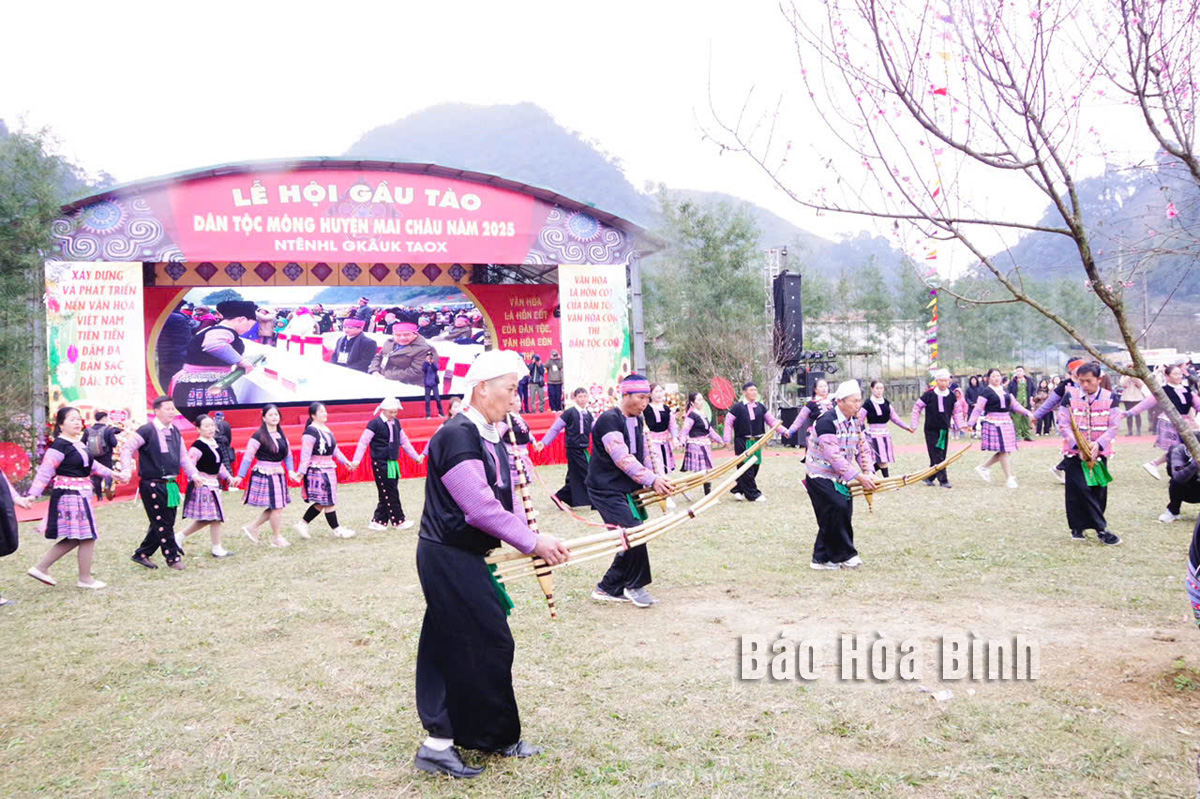
Gau Tao Festival, one of the most important traditional festivals of the Mong ethnic minority group in Mai Chau district was held at the Pa Co stadium in Pa Co commune on January 11.
Attending the festival were members of the Standing Board of the Hoa Binh Party Committee: Nguyen Van Toan, Permanent Vice Chairman of the provincial People's Committee; Vo Ngoc Kien, head of the provincial Party Committee’s Information and Education Board; and Colonel Do Thanh Binh, Director of the provincial Public Security Department. The event also saw Ding Cong Su, Vice Chairman of the provincial People's Committee; Dang Bich Ngoc, deputy head of the provincial delegation of National Assembly deputies; Colonel Trinh Duc Thiem, Commander of the provincial Military Command, among others.
The "neu” tree-planting and offering ceremony is the most important ritual of the Mong ethnic minority group’s Gau Tao Festival in the two communes of Hang Kia and Pa Co, Mai Chau district.
The Gau Tao Festival is a traditional folk festival, a long-standing cultural ritual and spiritual activity of the Mong people. In the two communes of Hang Kia and Pa Co, the festival has been revived since 2017. This year, the festival consisted of two main parts. The first part, the ceremonial activities, featured the key ritual of erecting the "neu” (bamboo pole) – a sacred symbol connecting heaven and earth. This part also included spiritual and cultural activities where offerings such as chickens, wine, rice, and paper were made to the "neu.” The ceremony leader lit incense, burned ghost money, and walked around the "neu” pole three times in a counter clockwise direction, then repeated the process while singing the "Tinh chay” song to announce to the deities that the "neu” had been erected, and to pray for a good year with favourable weather, bountiful harvests, and happiness and health for everyone.
As the festival drum sounds, the Mong people join in a traditional circle dance around the "neu” pole.
The festival includes a variety of exciting activities such as making sticky rice cakes, throwing "con” balls, tug-of-war, and more.
The festival also featured cultural performances showcasing the ethnic group’s identity, presented by young Mong men and women; tours of food, agricultural products, and unique items from the Mong community; traditional games like "pao” ball throwing, "tu lu” hitting, stilt walking, tug-of-war, and khen dance performances; sticky rice cake making contests; and traditional costume competitions.
Through the organisation of the Gau Tao Festival, the event contributes to the preservation, promotion, and honouring of the Mong ethnic group’s cultural heritage. Additionally, it enhances the introduction and promotion of the history, culture, and tourism potential of the two communes of Pa Co and Hang Kia to visitors. The festival fulfils the spiritual and cultural desires of the people in these two communes, fostering a healthy cultural environment and creating a joyful and optimistic atmosphere to welcome the Spring of the Year of the Snake. The Gau Tao Festival is closely linked to the worldview of the Mong people in the Northwest, reflecting their wishes for health, prosperity, favourable weather, abundant harvests, and growth.
The People’s Committee of Lac Son district held a ceremony on April 28 to receive the provincial relic certificate for the ancient rock carving site at Suoi Co stream, located in My Thanh commune.
A special music show titled "The country is in the fullness of joy” has been held at Hoa Binh Square in Hoa Binh city in celebration of the 50th anniversary of the liberation of the South and national reunification (April 30, 1975–2025).
The People's Committee of Lo Son commune, Tan Lac district, has organised the local annual traditional stream fishing festival on April 19 - 20.
As a land deeply intertwined with human history and Vietnam’s millennia-long journey of nation-building and defence, Hoa Binh is often revered for its epic tales and legends.
Residents of Hoa Binh boast a rich cultural identity, reflected in their unique language, traditional attire, customs, and folk melodies – described as "sweet as honey, clear as a mountain stream.”
Lac Son district’s Vu ban town held the 2025 Truong Kha temple festival on April 12–13 (the 15th–16th days of the third lunar month). Since its revival in 2019, the festival has been organised every three years, preserving valuable intangible heritage while meeting the community’s cultural and spiritual needs.



